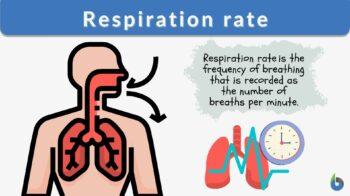
Respiration rate
n., plural: respiration rates
[ɹɛspɪˈɹeɪʃən ɹeɪt]
Definition: The respiration number in a minute of a person
Table of Contents
Respiration Rate Definition
Respiration rate is a vital life process that expresses the breathing rate in an organism (i.e., breathing rate per minute or brpm). Single respiration includes inhalation and expiration. It is considered a vital sign of life processes as it indicates the normal functioning of the life processes by the cell and tissues. Thus, respiration rate measurement is a fundamental patient assessment parameter.
Breathing and heart rate are important vital signs. Heart rate is also termed pulse rate. So, what is a normal pulse and respiration rate? The normal pulse rate is 60-100 bpm whereas the normal adult respiration rate is 16-20 breaths per minute.
In jist, what is a respiration rate? It is the respiration number in a minute of a person.
The breathing process or respiration is a metabolic process that supplies the essential oxygen to the body’s cells and expels out the carbon dioxide. Hence, the measurement of breathing rate or respiration rate is a vital parameter indicative of the health of an individual.
Abnormal respiration rate or breathing rate can be an indicator of a serious health issue like cardiac arrest. 12 to 20 respirations per minute is considered to be the average breaths per minute — or average respiration rate — or normal respiration rate. Conversely, a respiration rate above 25 or below 12 is considered to be abnormal. Thus, a person with 12-20 bpm is considered to have a good respiration rate.
As per a study, the average breathing rate while sleeping is 15-16 per minute. Congestive heart failure, fever, lung disease, asthma, anxiety, pneumonia, and use of narcotics or drug overdose are some of the health conditions wherein abnormal respiration rate is observed.
Respiration is a highly complex and coordinated process that involves multiple organs (brain, brainstem, lungs, airways, respiratory muscles, and blood vessels) structurally, functionally, and for regulatory purposes.
Respiration is regulated by respiration drive, which consists of the following three components:
- The central neural respiratory generator
- The sensory input system
- The muscular effector system
These three components work in sync to regulate and control the respiratory rhythm and respiratory volume. During respiration, the diaphragm plays an important role. For the inhalation, the diaphragm contract to increase the size of the thoracic cavity while, for expiration, the diaphragm relaxes. Thus the frequency and strength of the movement of the diaphragm determine the volume and frequency of respiration. The respiration drive works in sync to regulate the movement of the diaphragm.
Respiration rate is the frequency of breathing that is recorded as the number of breaths per minute. The normal adult respiration rate is 16 to 20 breaths per minute. A respiration rate above 25 or below 12 is considered abnormal. Persistent abnormal respiration rate or breathing rate may indicate health issues, e.g., cardiac arrest.
Types of Respiration Patterns
Respiration levels, rate, depth, and pattern are important health patterns.
- Normal breathing is termed eupnea.
- What happens when the respiration rate is high? The respiration rate higher than normal is termed tachypnea. Thus, a respiration rate higher than 20 breaths per minute is classified as tachypnea. Physiological conditions like pregnancy, exercise, emotional changes, pathological conditions like pulmonary embolism, pneumonia, foreign body aspiration, anxiety conditions, asthma, carbon monoxide poisoning, sepsis, diabetic ketoacidosis, etc. can result in higher respiration rate, i.e., tachypnea.
- What happens when the respiration rate is low? On the other hand, a respiration rate lower than 12 breaths per minute is termed bradypnea. Respiratory failure or, usage of depressants like alcohol, benzodiazepines, metabolic derangements, narcotics, etc. can result in slowing down of the respiration rate, i.e., bradypnea.
- Complete stoppage of airflow to the lungs for more than 15 sec is termed an apnea, as seen in cardiopulmonary arrests, airway obstructions, benzodiazepines, and the overdose of narcotics.
- Another parameter is the depth of respiration. An increase in the depth of respiration due to exercise, anxiety, infection, or congestive heart failure is termed hyperpnea.
- Increased rate and depth of breathing result in hyperventilation. Hyperventilation is commonly seen in cases of anxiety, diabetic ketoacidosis, or lactic acidosis. Reduced rate and depth of breathing result in hypoventilation as seen in metabolic alkalosis, obesity, and excessive sedation.
Respiration Measurement
Now let us understand, how to measure respiratory rate. Ideally, respiration rate has to be measured in the resting stage, even the activities like walking can change the respiration rate. The simplest method to measure the respiration rate involves counting the number of breaths per minute of a person in the resting stage, preferably the person should be seated on a chair or lying on the bed. Measurement of how many breaths per minute a person should be carried out in a relaxed state. The number of times the chest or abdomen rises in a minute should be noted down as the breathing rate i.e., normal breaths per minute is the respiration rate.
Normal Range in Adults and Children
What is a normal respiration rate? For adults, the normal breathing rate is 12 to 20 breaths per minute. However, the Normal respiration rate could vary with age. The elderly population or geriatric people may have a respiration rate of more than 28 breaths per minute i.e., tachypnea. Children have a higher respiration rate than adults and their respiration rate varies as per age of the child (Table 1). Children show a higher respiration rate; newborns breathe fast. The normal respiration rate for a newborn ranges from 40-60 bpm. Similarly, the normal heart rate for kids is higher than for adults.
Table 1: Pediatric respiratory rate by age, Respiration rate chart | |||
|---|---|---|---|
| Pediatric age | Normal range | Lower limit (1st percentile) | Higher limit (99th percentile) |
| 0-3 M (infant breathing rate) | 34-57 | 25 | 66 |
| 3M- <6M | 33-55 | 24 | 64 |
| 6M-<9M | 31-52 | 23 | 61 |
| 9M-<12M | 30-50 | 22 | 58 |
| 12M-<18M | 28-46 | 21 | 53 |
| 18M-<24M | 25-40 | 19 | 46 |
| 2y -<3y | 22-34 | 18 | 38 |
| 3y-<4y | 21-29 | 17 | 33 |
| 4y-<6y | 20-27 | 17 | 29 |
| 6y-<8y | 18-24 | 16 | 27 |
| 8y-<12y | 16-22 | 14 | 25 |
Data from: Dr. Amita Joshi of Biology Online.
Minute Volume
Minute volume is the air volume that is exhaled and inhaled within a minute. This parameter is useful for patients on ventilator support. Minute volume is calculated as a product of tidal volume and respiration rate. A higher minute volume indicates the expulsion of a higher amount of carbon dioxide while a lower minute volume is indicative of the expulsion of the lower amount of carbon dioxide. Accordingly, a hyperventilating patient will have a higher minute volume. The normal minute volume for an adult person is 6-8 lit in a minute.
More advanced techniques are available for the accurate measurement of the respiration rate:
- Impedance pneumography measures the electric activity during the inhalation and expiration process.
- Capnography monitors/estimate the carbon dioxide levels during breathing.
- Respiratory inductive plethysmography, Optoelectronic plethysmography, and Transthoracic impedance measurements are some of the techniques that are used in clinical settings for the continuous measurement of the respiration rate.
Diagnostic Value
Following are the diagnostic values for respiration rate (Table 2).
Table 2: Respiration rate diagnostic values | |
|---|---|
| Resp. rate range | Condition |
| 12-20 bpm | Normal breathing or respiration rate in a relaxed state i.e., Eupnoea |
| 12-25 bpm | Normal breathing or respiration rate in a relaxed state for a person above 65 years |
| 10-30 bpm | Normal breathing or respiration rate in a relaxed state for a person above 80 years |
| Less than 12 bpm | Bradypnoea- low breathing rate |
| More than 20 bpm | Tachypnoea- increased breathing rate |
Data from: Dr. Amita Joshi of Biology Online.
Abnormal Respiratory Rates
Abnormal respiration rate includes:
- Apnea: No breathing for more than 15 sec.
- Orthopnea: Difficulty in breathing when the person is in a lying position. Such patients can breathe without difficulty while sitting or standing. This can be an indicator of a possible heart attack.
- Dyspnea: The sensation of breathing difficulty
Paroxysmal nocturnal dyspnea: Attack of severe shortness of breath that wakes up a person from his/her sleep. This can be an indicator of a heart attack. - Hyperpnea: Deep and faster breathing than usual.
- Hyperventilation: Rapid and deep breathing that results in the expulsion of a higher amount of carbon dioxide than required.
- Hypoventilation: Shallow breathing that results in inefficient removal of carbon dioxide in the body resulting in the accumulation of a higher amount of carbon dioxide in the body than needed.
- Tachypnea: High respiration rate as compared to the normal rate of respiration for that age group.
- Kussmaul respiration: Intensification in the depth of ventilation (i.e., increase in tidal volume). However, the respiration rate remains the same. This is seen in patients with renal failure, salicylate toxicity, and diabetic ketoacidosis.
- Cheyne-Stokes respiration: This is an unusual breathing pattern wherein an intensification in the depth of ventilation is followed by periods of apnea or no breathing. This type of abnormal respiration is related to heart failure.
- Sighing respiration: This is involuntary breathing wherein 1.5 to 2 times greater tidal volume is inhaled. This is usually seen in patients with an anxiety attacks.
- Biot respiration: Herein regular deep respirations are intermingled with periods of no breathing or apnea
- Apneustic breathing: Abnormal breathing pattern wherein inhalation is normal however, complete expiration does not occur.
- Central neurogenic hyperventilation and Central neurogenic hypoventilation, results from an injury that causes respiratory centers to not respond to the respiratory stimuli.
Try to answer the quiz below to check what you have learned so far about respiration rate.
Further Reading
References
- Chourpiliadis, C., & Bhardwaj, A. (2019). Physiology, respiratory rate. Available from: https://www.ncbi.nlm.nih.gov/books/NBK537306/
- Cretikos, M. A., Bellomo, R., Hillman, K., Chen, J., Finfer, S., & Flabouris, A. (2008). Respiratory rate: the neglected vital sign. Medical Journal of Australia, 188(11), 657-659.
- Sapra, A., Malik, A., & Bhandari, P. (2021). Vital sign assessment. In StatPearls [Internet]. StatPearls Publishing. Available from: https://www.ncbi.nlm.nih.gov/books/NBK553213/
- Whited, L., & Graham, D. D. (2021). Abnormal respirations. In StatPearls [Internet]. StatPearls Publishing. Available from: https://www.ncbi.nlm.nih.gov/books/NBK470309/
©BiologyOnline.com. Content provided and moderated by Biology Online Editors.







